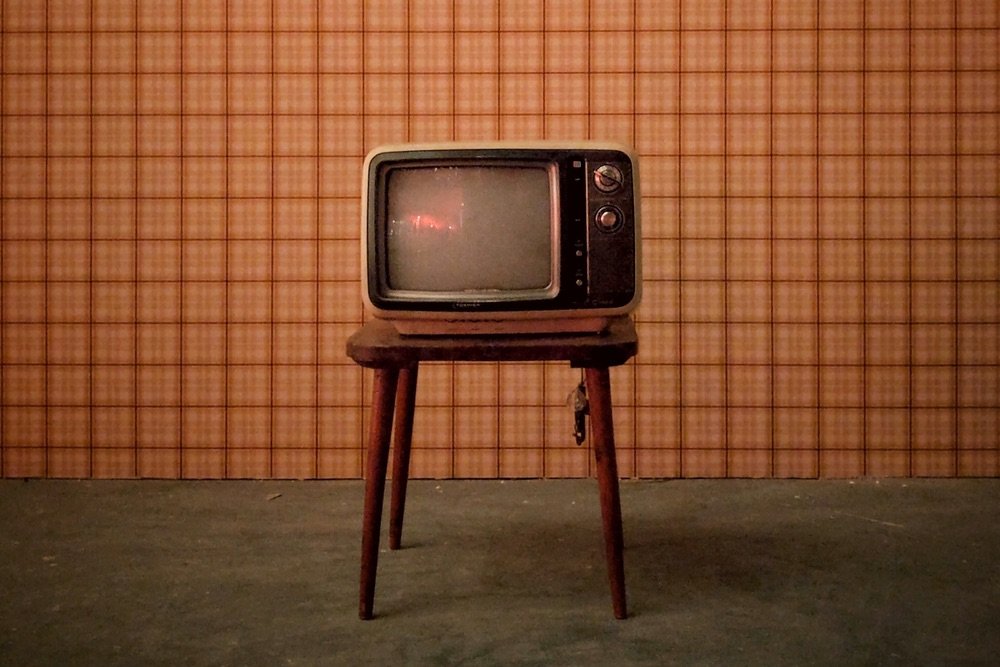
German Television Broadcasting
One of the most important weapons in the propaganda struggle of the systems of East and West was without doubt television.
The first public television broadcasts had already taken place in Germany before the Second World War. Since almost no one had their own television set, reception took place in public rooms, often in post offices, but also in military hospitals during the war. The Wehrmacht even used the Eiffel Tower in occupied France to set up a corresponding system in Paris. With the end of the war, television was initially history, most of the equipment and the broadcasting facilities were destroyed.
In the 1950s, television networks began to be set up again in West and East. On 20 December 1951, the first transmission and reception trials began in East Germany – but only as technical trials, because the first public television sets were not installed until 29 July 1952.
The radio receiver type Leningrad had been developed for private households and production began in the Sachsenwerk Radeberg. The receivers were sold from 16 November 1952. Almost 134,000 sets were manufactured until production ceased in 1954. However, 130,600 of them went to the Soviet Union as part of the reparations. In any case, only a few GDR citizens could afford the price of 3,500 GDR marks. After all, the average monthly income was 300 marks.
On 21 December 1952, Josef Stalin’s 74th birthday, a public trial programme began. A full two hours of daily broadcasting time from 8 p.m. was received by around 60 sets in Berlin.
The programme began with the Brandenburg Gate as the logo. After the welcome by the announcer Margit Schaumäker, there were words of greeting from the director and then as the first programme the Current Camera. Unlike later, it was not yet an instrument of the SED. As a news programme, it was anything but “current” at first, but viewers were used to the rhythm of the newsreels in the cinema anyway.
Surprisingly, the news broadcasts were initially quite objective. But that changed after the coverage of 17 June 1953. The director Zilles was dismissed and until the fall of the Berlin Wall his successor Heinz Adamek was an instrument loyal to the line of the SED.
Further transmitters led to a network that covered the whole of the GDR and large parts of West Germany.
In 1955 there was a first outside broadcast van whose technology would only make today’s journalists shake their heads.
On 2 January 1956, the experimental programme of the Berlin Television Centre ended and on 3 January, the German Television Broadcasting Service (DFF) began its programme. It was quite intentional that the station was not called Television of the GDR. The DFF was supposed to offer television for the whole of Germany. That’s why it also covered topics that might interest Westerners. But it was never technically possible for “East Television” to cover the whole of the Federal Republic. In contrast, the programmes of ARD and ZDF could be received throughout the GDR, with the exception of the Elbe valley and the north-east.
The Elbe Valley was therefore quickly nicknamed the “Valley of the Clueless”. Many GDR citizens built high antennas to enable reception. Of course, they were immediately in the Stasi’s sights.
The cost of television sets fell rapidly and by the end of 1958 more than 300,000 sets had been registered in the GDR. In this year the programme was extended in time. In addition, a repeat the next morning was introduced.
8 October 1958 saw the first broadcast of GDR television’s greatest success. “Unser Sandmännchen”, also called “Abendgruß vom Fernsehfunk”, was also watched by most children in West Berlin. Yet it was actually a plagiarism. The head of television, Walter Heynowski, had caught wind of the fact that on 1 December 1959, his colleagues at the West Berlin SFB had wanted to launch a sandman. So he ordered: “The opponent’s intention to take spectators from us must not be underestimated”.
In just one week, GDR television created its own Sandman. Just as the first man in space had to come from a socialist state, so it was with Sandmännchen. The West Berlin SFB then launched its own format on 1 December 1959: “Sandmännchen’s Greeting for Children”.
The GDR Sandmännchen became an export hit and survived the fall of the Berlin Wall. Even today, adults love the stories and the enormous variety of his vehicles. But once the Sandman made a huge propaganda mistake when he travelled in the basket of a balloon. That was only two days after a family from Thuringia had made a spectacular escape to Bavaria in a hot-air balloon.
Pittiplatsch and Schnatterinchen, Mr. Fuchs and Mrs. Elster and other characters were as well known to West Berlin children as to those in East Berlin.
Today, the term television radio is no longer heard in the Sandmann song, the second verse in question has been dropped.
In 1991, emerging rumours that the Sandman would be abolished triggered an outraged outcry. Across all party lines! The CSU media expert Markus Söder explained: “One of the best children’s programmes within ARD would even be broadcast on Bavarian radio if necessary. He added: “Sometimes the Bavarians have to be the last Prussians! With the merger of ORB and SFB to form RBB, Sandmännchen became a co-production of RBB, MDR and NDR, with RBB taking the lead.
In 2019, the Sandman is still good for a wave in the media world. An RBB report that the Sandman would lose his beard was picked up by almost all other broadcasters. A shitstorm followed and the RBB phones did not stand still. The outraged viewers had overlooked the date, it was 1 April.
Other formats were also as popular in the West as they were in the East, such as Willi Schwabe’s Rumpelkammer. In it, the presenter combined old film clips with anecdotes. Many of the films were from the time before the Second World War or even the Third Reich. It helped that in the major feature films of the Nazi era, Nazi symbols were hardly ever to be seen. In contrast to GDR film production, there were hardly any contemporary uniforms to be seen. With 35 years and over 400 broadcasts, it was one of the longest-lived entertainment formats in German television history. Schwabe’s death did not end it, Friedrich Schoenfelder took over until 1990. The programme still achieved its old popularity, but was now considered no longer modern enough by the new directors due to the changed TV landscape and was simply cancelled.
The very popular GDR crime series Polizeiruf 110 survived the fall of communism.It was created in 1971 as a counterpart to the West German Tatort. The fundamental problem was the ideological determination that socialist man could not be criminal. But the West German crime films were simply too popular. So they simply had to create a GDR counterpart. The places of action were spread all over the GDR from the Baltic Sea to the Erzgebirge mountains. They were never mentioned by name, but could sometimes be deduced from the circumstances.
Unlike Tatort, Der Alte, Derrick and other western series, topics such as alcoholism, child abuse, burglary, blackmail, fraud, theft, juvenile delinquency and rape were also dealt with. The Polizeiruf was one of the few GDR television programmes that dealt with grievances, but the finger of blame was always there.
One widespread GDR problem in particular came up again and again, alcoholism. Alcohol was presented as a contributory cause for criminal development, but it never served as an excuse.
In 1988 a taboo was broken. In the episode “Crossword Case”, the sexual abuse and murder of seven-year-old Lars Bense in 1981 in Halle-Neustadt was traced in great detail.
The changes were built in during the Wende. SED propaganda posters hang demonstratively askew, a commissar even says that he can imagine a person getting a job not because of his convictions but because of his abilities. A statement that would have been impossible under Honnecker.
In today’s police episodes, murder is the usual crime. A sad side effect is that former GDR citizens believe there are more homicides today. In Germany today, there are fewer than two a day. The SED ensured that the statistics were embellished. Murders were not even shown separately in them.
The 20th anniversary of the GDR was set as the starting point for colour television. The 2nd programme of Deutsches Fernsehfunk started in colour on 3 October 1969. In contrast to the start of the first programme, Walter Ulbricht was now a politician who had the programme started with the words “The second television programme is open”. The first programme remained black and white for years.
The technical difference between the West German PAL and the GDR Secam initially made colour reception in the West impossible. It was not until the 1970s that sets were produced that could receive both. In 1978, the Chromat 1060 was produced in the GDR as well. Before that, resourceful hobbyists had built in decoders. They were helped by the fact that many televisions were produced in the GDR for the western market. Many a component disappeared from the warehouses.
From an average of 15 broadcast hours per week at the beginning of the DFF, it had reached 132 in 1975. The broadcasting time increased to 177 hours by 1988.
Television in the GDR
The year 1972 brought a change in self-image; the DFF was renamed Fernsehen der DDR (Television of the GDR). However, the old designation remained with Sandmännchen.
In terms of content, the change had already taken place much earlier. Die Aktuelle Kamera had degenerated into a faithful organ of state power. The programme structure was clear. First there was reporting on the SED, followed by news from the GDR. This was followed by foreign reports from socialist countries and only at the very end those from “capitalist foreign countries”.
The intention of the propaganda programme “Der Schwarze Kanal” was much more transparent. which started as early as 1960 as a response to the western programme “Die Rote Optik”, which had been running since 1958.
The opening credits showed a federal eagle hopping around on a forest of antennas and then crashing down headfirst. A black-white-red breast band was supposed to establish a connection to national conservative circles.
The programme started after the popular feature films, so it was hoped to reach many viewers in the West and East. But this was a misconception, the private television set was usually switched over.
In the GDR, the moderator’s nickname was, Karl-Eduard von Schnitzler, for most people only Karl-Eduard von Schni. This indicated that people switched over immediately when the name was mentioned. Some simply called the programme “Knacks”, the onomatopoeic sound of the operation of the rotary switches of the time. In the West, the presenter was known as “Sudel Ede”. Wolf Biermann adopted the name in a ballad. Ede would still be lying to the worms in his grave. From an initial audience of 25%, the number of viewers soon dropped to less than 10%. Since the Schwarze Kanal was compulsory programming for the NVA and other organisations loyal to the line, this figure becomes even more relative. In the West, it was almost only watched by ultra-leftists. But even among them, the often clumsy rhetoric did not go down well. A West Berlin friend (CDU direction) said: “I watch a few minutes of Der Schwarze Kanal every few months. Then my image of the enemy is back in full force.”
Vicious laughter spread when Schnitzler’s fourth wife, Márta Rafael, was caught stealing two packs of ladies’ stockings by the shop detective in a well-known West Berlin department stores’ in 1983. The West German media, of course, reported the theft. reported again and again. Schnitzler had always cheered the building of the Wall, but was one of the few GDR citizens who were allowed to go to the West at any time. Every week the family went shopping in West Berlin.
The format survived until the fall of communism.
Schnitzler also produced documentaries. The audience rating for Schnitzler’s documentaries, which was kept secret in the GDR, was only seven percent; the use of manipulated film material was simply too obvious.
But there were also successful new series. Starting in 1974, “Zur See” portrayed the adventures of the crew of the motor ship Fichte at sea and on shore leave in nine episodes. Many prominent GDR actors were engaged for the leading roles. Four years after the first broadcast in the GDR, the series was also shown on West German television. The ship was an obsolete freighter, the film crew also jokingly called the ship because of its age and condition: “Three years after the end of the series, it was sold for scrap.
This was followed in 1985 by “Treffpunkt Flughafen”, a similar series about the experiences of an Interflug crew. Both series represented a balancing act. Traumschiff, Love Boat and similar western series had shown the GDR citizens the wide world. They wanted to replace the series of the “class enemies” with good socialist entertainment. But here, too, the citizens saw the colourful world behind the Wall. Even if the foreign scenes were mostly set in socialist brother states, the longings were only intensified, not satisfied. With the Arkona, the GDR had a modern cruise ship from 1985, but it was often chartered out to western tour operators to earn urgently needed foreign currency. Thus there was no GDR dream ship series.
In 1989, the SED increasingly tried to bind young viewers to the GDR programmes. The youth programme Elf 99 (based on the postcode of the station)
The muzzle was loosened somewhat. From the end of October 1989, mass flight and protests were also reported on, topics that had previously been absolutely taboo. Immediately after Honecker’s resignation, GDR radio and television reformed their programmes. But even before that, the number of viewers of the news programmes had shot up to unimaginable heights. People in the GDR began to trust the reports.
On 30 October 1989, the propaganda programme The new programme “Klartext” replaced the Black Channel.
But still the platitudinous slogans of the SED were presented as eternal truths. The chief editors had to do what the SED wanted. It was Erich Honecker himself who formulated sentences such as the famous one from autumn 1989: “The GDR does not shed a tear for those who fled the republic.
The new openness boosted the ratings of “Die Aktuelle Kamera” to over 40 per cent. But Honecker’s successor Egon Krenz complained on 9 November about the great media interest in the demonstrations throughout the country. “Yesterday I received the confidence of the Central Committee on the assumption that together we want to implement a policy of renewal, but not the policy of allowing the opposition in the press, radio and television.” An eternally yesterday’s attitude, already in the evening the next blow hit: Günther Schabowski announced the “new travel regulations” and thus inadvertently opened the Wall. The announcement in the “Aktuelle Kamera” was read by Angelika Unterlauf.
The good-looking journalist read the GDR news in a voice that was always equally expressionless. That’s exactly how the GDR leadership wanted it. In 1980, a slip of the tongue almost ended her career. Instead of “600 books are on their way to Vienna”, she read: “600 citizens are on their way to Vienna”. The head of the department yelled at her afterwards and said: “You won’t read the news here any more, I’ll make sure of that,” Unterlauf later told Stern. But she was lucky. It was not until July 1990 that she lost her job and moved behind the scenes to Sat1 as an editor. The last Current Camera was published on 14 December 1990.
The new news programme AK Zwo of Aktuelle Kamera was taken over by 3Sat in the West on 9 November due to current events.
The cooperation continued, but at first it was further monitored by the Stasi. The talk show “Thursday Talk” with audience participation by telephone put the callers on the surveillance lists of the state security. MfS employees also sat in the studio.
On 12 March 1990, the programmes DDR-F1 and DDR-F2 became DFF 1 and DFF 2 again. The GDR Media Act of September 1990 changed the status of the DFF to a public service broadcaster.
In the middle of 1990, more attention began to be paid to the regions. Special programmes were increasingly produced. On 13 August 1990, DFF began broadcasting daily regional programmes.
With reunification on 3 October 1990, the DFF lost its independence under public law. Article 36 of the Unification Treaty stipulated that the DFF was to be dissolved with all programme material, properties, staff and other property by 31 December 1991 at the latest. The final shutdown of the DFF took place at midnight on 31 December 1991.



